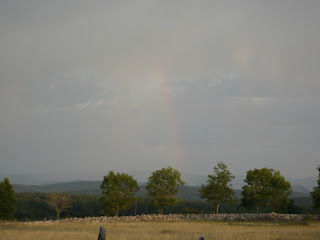Looking at the letters of Charlotte Bronte and seeing how the weather could affect health (see blog post below) it led me to read the Babbage Report of 1850.
Written by Benjamin Herschel Babbage it was a "Report to the General Board of Health, on a Preliminary Inquiry into the Sewage, Drainage, and Supply of Water, and the Sanitary Conditions of the inhabitants of Haworth..."
The report was undertaken after the inhabitants of Haworth signed a petition to the General Board of Health to direct a Superintending Inspector to visit the town and conduct an inquiry.
Some of the points of the report are shocking:
"the mortality per thousand, it will be observed that it ranges from 19 in the thousand to 30.6, which the latter is a rate of mortality only to be met with in very unhealthy places."
" The average age at death in this hamlet is very low; it will be seen... that it ranges from 19.6 years to 30.8 years, and that, taking the whole 12 years the average age at death is 25.8, which is about the same as in Whitechapel, St.George-in-the-East, and St.Luke, three of the most unhealthy of the London districts"
"It will be seen that the infantile mortality is very great, since 41.6 per cent of the population die before attaining the age of six years"
Babbage reports on the manufactures and trades of the town, sanitary conditions and water supply as well as the highways and burial grounds.
"I found 24 houses lower down in the main street, with only one privy amongst them"
"There are no sewers in Haworth; a few covered drains have been made in some of the streets to carry away the surface water, as for instance, in the upper part of the main street and down Back-Lane, but generally the drainage runs along in open channels and gutters. As a necessary consequence of the want of sewerage there is contiguous to each privy a recepticle for the night soil, in some cases walled round, in other cases fenced in with upright stones on edge; into these midden-steads are thrown the household refuse and the offal from the slaughter-houses, where mixed with the night soil, and occasionally the drainage from pigsties, the whole lies for months together, decomposition goes on and offensive smells and putrid gasses are given out. These midden-steads are uncovered, and the majority of them are nearly full when i examined them. Bad as they are, their situation, in close proximity to dwelling-houses, makes them much more injurous."
The seasons weather conditions are mentioned with connection to the water supply:
"It was stated to me... that about 150 houses are dependant for their supply of water upon the Head well, and that the supply from it is so scanty in the summer time, that in order to have water for the Monday's washing, the poor people are in the habit of going there at 2 or 3 o'clock on Monday morning, in order to wait for their turn, to fill their cans and buckets from the slowly running stream. It was also stated that the water of this well is very bad at this season, and that it is sometimes so green and putrid, that cattle which have been driven there to drink, after tasting the water, have turned away and refused to touch it again."
" the existing drains open into the fields at several points immediately below the main street, and the drainage is led in open ditches to irrigate these fields. Complaints were made that some of this drainage water got into a watercourse, which supplied some detached houses at Mill Hill with water. I should conclude that this use of the drainage matters in immediate vicinity to the houses, would in warm weather prove prejudicial to the health of the persons living in the neighbourhood."
Babbage makes recommendations and suggests remedial measures to address (amongst other things) the bad drainage and water supplies to Haworth. I haven't found when the recommendations were carried out - but having visited Haworth recently I can assure anyone who hasn't been to Haworth that the work has been done.
Here is the report - it's a great read:
Babbage Report

















